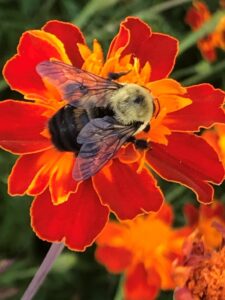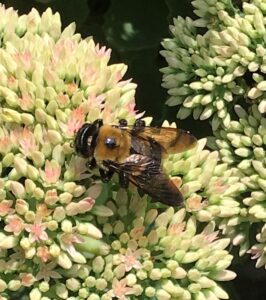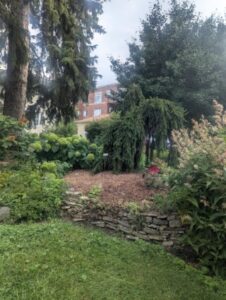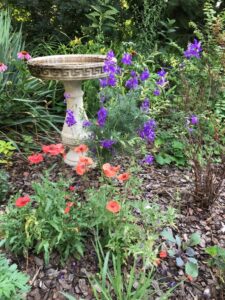Sep
18
2025
 By Kerry Perry
By Kerry Perry
It’s all a buzz at the Kruse Garden. We have an enormous variety of perennials that the bees and other pollinators love. Blooming now is calamint, sedum, blue lobelia, golden rod, joe-pye weed and others. Look closely and you’ll see lots of different insects. There are around 500 species of bees native to Illinois. Surprise, honey bees are non-native.
 [For the rest of the photos, see the September Newsletter] Can you identify the five insects in these photos I took at Kruse? Let me know at the next meeting. You might “bee” a prize winner!
[For the rest of the photos, see the September Newsletter] Can you identify the five insects in these photos I took at Kruse? Let me know at the next meeting. You might “bee” a prize winner!
The Kruse Garden is in need of 10-12” round rocks suitable for edging a garden bed as well as 12″ or slightly large pieces of flagstone to help stabilize some plantings on one of the sloping garden beds. We are also accepting any donations of large to giant hostas varieties you may be fall dividing from your own garden. Please email the club westchicagogardenclub@gmail.com
Aug
21
2025
By Barbara Darrah

I am writing this article with a bit of hesitancy because since July 18 when my husband Dick had knee replacement surgery, I became his “designated driver” and have spent my Wednesday mornings ferrying him to his therapy sessions. I am sure that the crew members managed very well without me but I have missed our gardening together.
This has been a very strange and exhausting summer for all of our gardening as well. These super hot and humid days seem to just suck our energy out of us. Many plants seem to have outdone their normal growth patterns. The clover and creeping Charlie have made a concerted effort to take over our lawns and in the flower beds that I hoped were weedless, there are three and four foot invaders towering over the blossoms. The Joe Pyeweed has flopped completely over and deadheading seems endless. We are all working overtime along with the industrious Kruse crew.
I hope you have taken advantage of the Tuesday Open House at the garden. If you still haven’t had a chance to tour the house, do try to do so. Most house museums showcase the large, expensive houses of the upper classes. Thanks to the Kruse sisters’ gift to the community, we have the unique opportunity to visit an early twentieth century remarkably complete example of the small town home that your midwestern great, great grandparents probably lived in. And the docents seem to ensure that there is always something new to see every time that you visit. Thanks to our garden club volunteers, you also get to see a charming garden as well.
We welcome you to visit Kruse House Gardens and if you are interested in working in the gardens we are there Wednesdays, 9:00 to 11:30am.
Tags: Kruse Garden
Jul
17
2025
 By Kerry Perry
By Kerry Perry
The Kruse Garden is in full bloom and looks fabulous.
In keeping with the Club’s mission statement, we are committed to preserving the nearly one-acre garden at the Kruse House Museum.
We would greatly appreciate any volunteers who can spare some time to pull a few weeds, dead-head spent flowers, trim a few shrubs, refill the bird baths….your choice. Get your hands dirty and spend an hour, part of a morning, a couple of hours one evening. Please help!
Everyone is welcome to visit any time at 527 Main Street, West Chicago. Our regular work day is Wednesday 9 – 11:30. Contact us for other times at WestChicagoGardenClub@gmail.com.
 By Kerry Perry
By Kerry Perry [For the rest of the photos, see the September Newsletter] Can you identify the five insects in these photos I took at Kruse? Let me know at the next meeting. You might “bee” a prize winner!
[For the rest of the photos, see the September Newsletter] Can you identify the five insects in these photos I took at Kruse? Let me know at the next meeting. You might “bee” a prize winner!
 By Kerry Perry
By Kerry Perry - Membership
- Membership